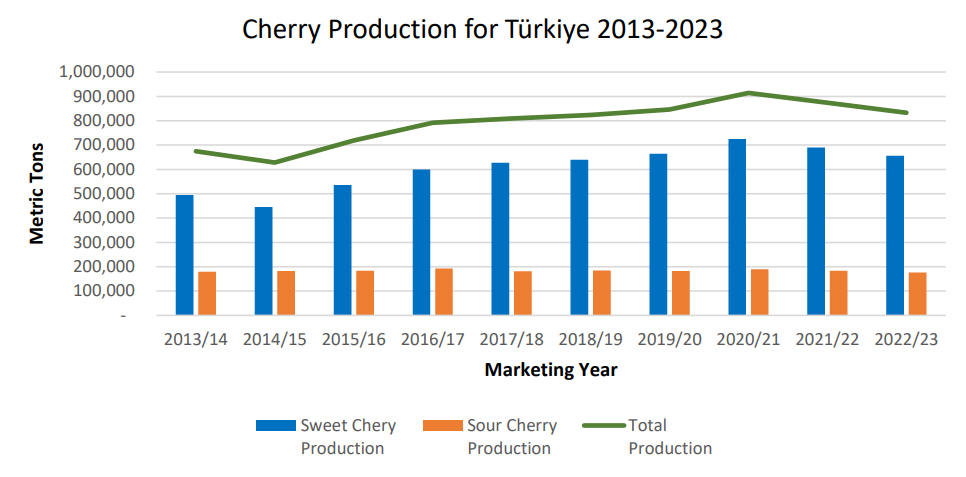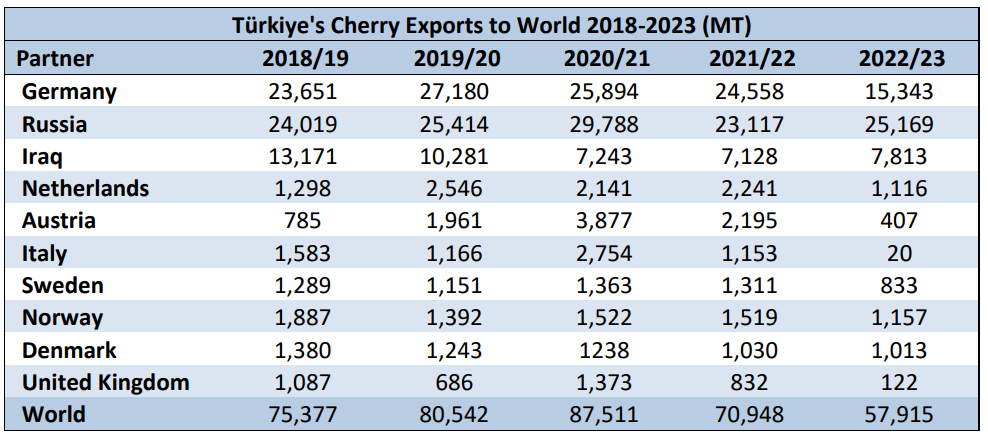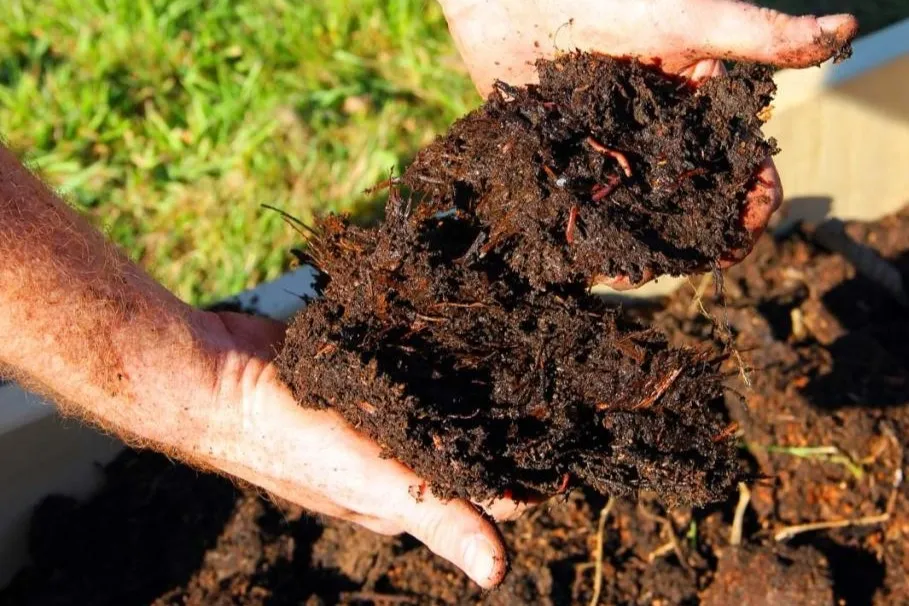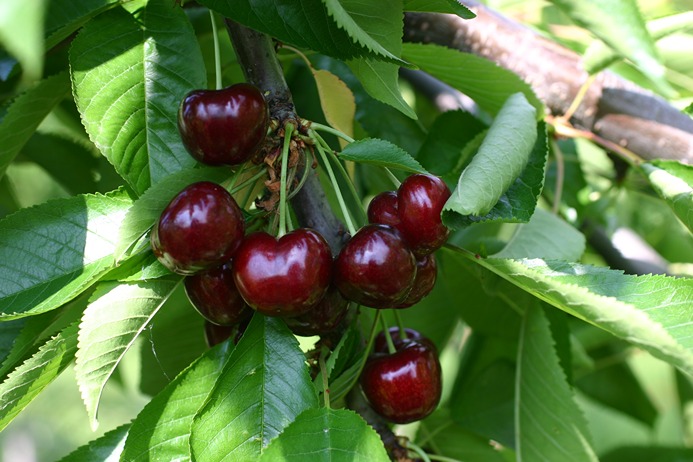Türkiye has historically been among the top cherry producing countries in the world, often finding itself among the top four exporting countries. Sweet cherries are grown mainly in the Central Anatolia, Aegean, Marmara, and Mediterranean regions. Konya, Izmir, Manisa and Denizli are the top cherry producing provinces within these regions. The marketing year for cherries begins in late April. For the MY 2023/24 season, Post forecasts total cherry production to be up year to year at 900,000 MT, of which 720,000 MT are sweet cherries and 180,000 MT are sour cherries.
Türkiye is one of the largest exporters of stone fruit in the world, exporting more than 250,000 MT annually, with the majority going to the EU and Russia. In recent years, Turkish exporters have also been looking for opportunities for stone fruits (such as cherries) in the Far East, particularly South Korea.
Planting area
Türkiye is the world’s leading sweet cherry producer. Enjoying increasing demand from export markets in recent years, Turkish farmers have invested in new orchards, uprooted non-commercial varieties, and replanted tree varieties that are more competitive.
There are also new investments being made in juice production. Turkish sweet cherry planted area was on the rise a decade ago, however in recent years it has seen a slight decline (Figure 1). Post estimates the sweet cherry planted area at around 82,000 hectares (ha) and sour cherry planted area to stay around 20,000 ha in MY 2023/24.
Total cherry planted area in MY 2023/24 is expected to be about 100,000 hectares, slightly less than MY 2022/2023. Overall, total planted area for cherries has decreased slightly since the record in MY 2017/18 (Figure 1).

In the last ten years, scientists have been trying to increase yields and quality of the native Napoleon Cherry. A scientist from Suleyman Demirel University has developed three, higher yielding Turkish Napoleon types. Following these improvements, farmers have been replacing their older varieties of Turkish Napoleon sweet cherry trees with the enhanced versions, leading to Türkiye’s increased production compared to decreasing planted area (Figures 1, 8).
According to Turkish official data, the total estimated number of cherry trees in the country was about 27.8 million in 2022. The total number of bearing trees for sweet cherries increased from 18 million to 22 million in ten years. The total number of bearing trees for sour cherries has remained stagnant (Figures 2, 3).


Türkiye is the location of many valuable cherry genetic resources because of the fruit’s origin in northern Anatolia. There are more than 100 varieties of sweet cherries produced in Türkiye.
The 0900 Ziraat variety, also known as the Turkish Napoleon, was developed in Türkiye and is the most popular because it meets the higher quality characteristics demanded by export markets. It is heart shaped, with pink and red fruit flesh, bright, firm, juicy, very large, suitable for transportation and has a long shelf life.
However, producers have started to try new cherry varieties such as Sweetheart, Celeste, Early Lory, Kordia, Regina, Sam, and Sunburst for higher quality products, later harvests (to capture higher prices later in the season), and higher yields.
Production
Sweet cherries are grown mainly in the Central Anatolia, Aegean, Marmara, and Mediterranean regions in Türkiye. Konya (10.3 percent), Izmir (10 percent), Bursa (9.2 percent), Manisa (7.3 percent), and Amasya (5.8 percent) are the top cherry producing provinces within these regions (Figure 7).
The marketing year for cherries in Türkiye begins in late May and lasts through early August. The exact timing of the cherry season can vary depending on the region and weather conditions, but generally, the peak harvest period for cherries in Türkiye is in June. While the cherry harvest starts on the Aegean coast in Izmir in late May, it begins in June or July further inland in Afyon, Burdur, Salihli and Konya. Farmers harvest cherries in Kahramanmaras in August.

For the MY 2023/24 season, Post forecasts total cherry production to be 900,000 MT, of which 718,000 MT are sweet cherries and 182,000 MT are sour cherries, due to favorable weather and growing conditions. TurkStat’s first yearly estimation reports an 18.6 percent increase in sweet cherry production for MY 2023/24 to 778,065 MT, compared to the total production of 656,041 MT in MY 2022/23 on May 20232 .
Generally, the soil in major production areas received enough rain to achieve higher yields, and there was no frost damage this year. The only challenge this season for farmers was a delayed harvest due to the late arrival of warmer spring temperatures. Sour cherry production remained at similar levels to previous years, which has averaged around 183,000 MT over the last 10 years. Higher yields caused sweet cherry prices remain stagnant this year in TL, even though severe food inflation rocked the Turkish economy.
At the time of this report (August 18th 2023), the retail cost of sweet cherries is in the range of 50-90 Turkish Lira (TL) per kilogram (kg) ($1.85-$3.33). Sour cherry prices are around 70-90 TL per kg ($2.59- $3.33) in retail stores. In U.S. dollars, both sweet and sour cherry prices are lower compared to last year, since today the U.S. dollar exchange rate is 50 percent higher than last year around this time. Input prices are increasing sharply due to the weak TL against foreign currencies and hyperinflation in Türkiye.
From March 2022 to March 2023 fertilizer prices have increased around 20 percent, pesticides prices around 35 percent, and energy prices around 11.5 percent3 . From March 2023 to August 2023 fertilizer prices increased another 42 percent and fuel prices increased around 50 percent because of sudden increases in the exchange rate. Farmers are struggling to keep up with the rapidly increasing input prices.

Strong export demand in recent years has been the driving force behind increased cherry production. Türkiye has been slowly transitioning from traditional to modern cherry production, including the development of modern, high-density orchards, using new cultivars, rootstocks, training systems, and growing techniques.
However, most cherry production is still carried out using predominantly traditional methods among agricultural holdings operated by family-owned farms. A relatively cheap labor force of seasonal workers and family-owned farms provides the advantage of a stable, affordable labor supply.
Because of the growth in the export market, the production of Turkish sweet cherries increased by 24 percent from MY 2013/14 to MY 2022/23 (Figure 8). The increase in production of better-quality cherries to meet the specifications of export markets has also helped increase the quality of cherries for the domestic market. Production of sour cherries, however, remains steady, as the fruit is used primarily in the juice and jam industries in Türkiye.
Consumption
Over one hundred different varieties of cherries are consumed in many forms in Türkiye. Domestically, more than half of the sweet cherries produced in Türkiye are consumed fresh. Approximately 20 percent of all cherry production is used in the processing sector to make canned products, marmalades, frozen fruits, and juice.
Most processed products are made from sour cherries. In MY 2023/24, domestic consumption is estimated to be approximately 823,000 MT, which is an increase of 48,100 MT compared to the previous marketing year.
Trade
Türkiye exports more than 250,000 MT of stone fruit annually, with the majority going to the EU and Russia. Besides Türkiye, Chile, the United States, and Hong Kong are the other leading global exporters. Turkish exporters continue to seek expanded opportunities for stone fruit exports in South and East Asia.
Türkiye’s exports of fresh cherries decreased in the last 2 years due to decreased production (Figure 10), however in MY 2023/24, Post estimates Türkiye’s fresh cherry exports to be 77,000 MT, an increase of around 33 percent compared to MY 2022/23’s export volume of 58,000 MT due to higher production and stable demand from EU countries.

Türkiye has also increased its exports to markets in Russia and the EU in recent years. Russia (25,169 MT), Germany (15,343 MT) and Iraq (7,813 MT) are the main destinations for Turkish cherries in MY 2022/23 (Table 1).

Marketing
In recent years there has been a considerable increase in terms of sweet cherry production and marketing. Türkiye has seen an increase in the number of marketing-savvy firms, more investments made in cold storage, and additional packaging factories.
Farmers have been trained to produce sweet cherry varieties demanded by export markets. The number of market-conscious merchants who know the export markets and regulations has also increased.
The Turkish government has been subsidizing farmers who rehabilitate their old sweet cherry orchards to produce higher quality sweet cherries for the export market. In terms of sweet cherries, domestic consumption and preferences have remained at similar levels over the years, whereas the export of sweet cherries continues to increase by utilizing the right marketing strategies.
Policy
Stable export demand and government supports have helped Turkish farmers to invest in new stone fruit orchards. There are payments for producers who are registered in the Ministry of Agriculture and Forestry’s farmer registration system. The Ministry of Agriculture and Forestry announced a subsidy program for farmers who are returning to their villages to establish orchards in 2023.
According to the program, farmers can benefit from a 30,000 TL ($1,667) subsidy plus a 100,000 TL ($5,556) cash credit if they can fulfill the qualifications. More information can be found at the Ministry of Agriculture and Forestry Website.
The Ministry also continues providing supports for fuel and fertilizer, standard and certified saplings, organic farming, and sample analysis. This program supports farmers’ investments to buy government-certified dwarf saplings, ensuring higher quality trees are being planted in Türkiye. Türkiye also subsidizes juice exporters through various export programs, such as giving subsidies for digital commerce, attendance at trade fairs, conducting market research, etc. More information can be found at the Ministry of Trade website.
Source: USDA
Photo: CharlesFred
Cherry Times - All rights reserved

















